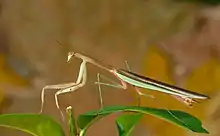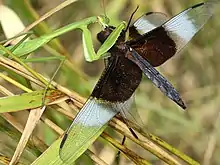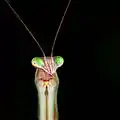Chinese mantis
The Chinese mantis (Tenodera sinensis) is a species of mantis native to Asia and the nearby islands. In 1896, this species was accidentally introduced by a nursery tender at Mt. Airy near Philadelphia, United States.[2] Tenodera sinensis often is erroneously referred to as Tenodera aridifolia sinensis because it was at first described as a subspecies of Tenodera aridifolia, but Tenodera sinensis is now established as a full species.[3]
| Chinese mantis | |
|---|---|
 | |
| Adult male | |
| Scientific classification | |
| Domain: | Eukaryota |
| Kingdom: | Animalia |
| Phylum: | Arthropoda |
| Class: | Insecta |
| Order: | Mantodea |
| Family: | Mantidae |
| Subfamily: | Tenoderinae |
| Tribe: | Tenoderini |
| Genus: | Tenodera |
| Species: | T. sinensis |
| Binomial name | |
| Tenodera sinensis (Saussure, 1871) | |
| Synonyms | |
Tenodera sinensis feeds primarily on other insects, though adult females sometimes catch small vertebrates. For example, they have been observed feeding on hornets, spiders, grasshoppers, katydids, small reptiles, amphibians, and even hummingbirds.[4] Like most mantids, they are known to be cannibalistic. One study found that cannibalism occurs in up to 50% of matings.[5] These mantids have been observed eating the larvae of monarch butterflies, while discarding the entrails.[6]

Description

The Chinese mantis is a long, slender, brown and green praying mantis. It is typically longer than other praying mantis species, reaching just over 11 cm (4.3 in), and is the largest mantis species in North America (spread throughout the Northeast United States). Its color can vary from overall green to brown with a green lateral stripe on the borders of the front wings in the brown color form. In low light, the eyes of the mantis appear black, but in daylight appear to be clear, matching the color of the head. Chinese mantids look similar to another mantis species that has been introduced to the United States, the narrow-winged mantid (Tenodera angustipennis). Tenodera sinensis and Tenodera angustipennis are similar in appearance, however you can tell them apart by locating a spot in-between their front legs. If it is yellow then it is a Chinese mantis but if it is orange then it is a narrow-winged mantis. The female can produce several semi-spherical oothecae, roughly 2 cm (0.8 in) in diameter, containing up to 300 eggs.[2] The oothecae are often affixed to vegetation such as bushes and small trees.
.jpg.webp)
Native range
This mantis is native to China, Japan, the Korean Peninsula, Micronesia, and Thailand.[1] Populations of T. sinensis in Japan are sympatric with Tenodera aridifolia, the Japanese giant mantis, of which T. sinensis was formerly considered a subspecies.
Growth
Chinese mantises hatch in the spring, eat, grow, and molt through the summer, and lay eggs at the end of summer. When it gets too cold, they die, only living around a year long.[7] First instar nymphs that eat less take a longer time to molt to the next instar and are smaller at the second instar than first instar nymphs that have been fed more.[8]
Captivity
Tenodera sinensis is a common pet for mantis enthusiasts, and oothecae can be purchased from plant nurseries across the US.[9]
Predators
The Chinese mantis is preyed on by other mantises, birds, and the Asian giant hornet in its native range.[10] The female mantis specifically preys on male mantises. She often kills and eats her male partner after mating, providing nutrition for her offspring[11] Sexual cannibalism is a strange phenomenon not yet completely understood by scientists.[12]
Similar species
The European mantis (Mantis religiosa) and the Carolina mantis (Stagmomantis carolina) are both smaller mantises closely resembling the Chinese mantis.[13] The European mantis is anywhere from tan to green in color and about 7.5 cm (3 in) long.[14] The Carolina mantis, on the other hand, is only 6 cm (2.5 in) in length and varies more in color.[15]
Culture
There are two martial arts styles created to mimic the movements of the Chinese mantis. Developed in the Shandong province of China in the mid-1600s, Praying Mantis kung-fu is based on the quick movements and techniques of the Chinese mantis. An unrelated style of kung fu that was developed by the Hakka people in Southern China is known as Southern Praying Mantis.
Master Mantis, one of the supporting characters in the 2008 Dreamworks Animation film franchise Kung Fu Panda, is a Chinese mantis and one of the members of the Furious Five.
Gallery
 Adult male
Adult male Adult female
Adult female Adult at rest
Adult at rest Adult female Tenodera sinensis eating a long-horned grasshopper
Adult female Tenodera sinensis eating a long-horned grasshopper Sub-adult female in hand
Sub-adult female in hand
See also
References
- "Archived copy". Archived from the original on 2014-10-13. Retrieved 2014-01-13.
{{cite web}}: CS1 maint: archived copy as title (link) Texas A&M University - Blatchley, Willis Stanley (1920). Orthoptera of northeastern America: with especial reference to the faunas of Indiana and Florida. The Nature Publishing Company. pp. 122–123.
- Ehrmann, R. 2002. Mantodea: Gottesanbeterinnen der Welt. Natur und Tier, Münster
- "Praying Mantis: Hummingbird Predator". 17 April 2015.
- Brown, William D.; Barry, Katherine L. (2016). "Sexual cannibalism increases male material investment in offspring: Quantifying terminal reproductive effort in a praying mantis". Proceedings of the Royal Society B: Biological Sciences. 283 (1833). doi:10.1098/rspb.2016.0656. PMC 4936037. PMID 27358366.
- "Chinese Mantis Guts Its Toxic Caterpillar Prey". 25 January 2013.
- "Chinese Mantis". Missouri Department of Conservation. Retrieved 2021-09-29.
- Duss, K.; Hurd, L E (1997). "Food limitation reduces body length in mantid nymphs, Tenodera sinensis Saussure (Mantodea: Mantidae): Implications for fitness". Proceedings of the Entomological Society of Washington. Vol. 99. Washington, etc. :Entomological Society of Washington. pp. 490–493. ISSN 0013-8797.
- "Chinese Mantis". Missouri Department of Conservation. Retrieved 2023-01-31.
- "- YouTube". YouTube.
- "Making a meal of it: Praying mantis cannibalism explained". phys.org. Retrieved 2021-09-29.
- Prokop, Pavol; Maxwell, Michael R. (2016-02-10). "Female predatory response to conspecific males and heterospecific prey in the praying mantis Mantis religiosa: evidence for discrimination of conspecific males". Journal of Ethology. 34 (2): 139–146. doi:10.1007/s10164-016-0458-8. ISSN 0289-0771. S2CID 15224163.
- "Chinese Mantis". Missouri Department of Conservation. Retrieved 2021-09-20.
- "European Mantis". Museum of Natural History. 2020-12-09. Retrieved 2021-09-24.
- "Carolina Mantid | NC State Extension Publications". content.ces.ncsu.edu. Retrieved 2021-09-24.